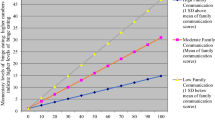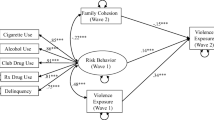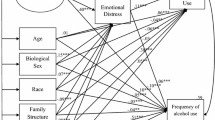Abstract
Despite early theories suggesting that family dysfunction (FD) may cause disordered eating, FD has been linked with other disorders and is a non-specific risk factor for disordered eating. We examined one potential model of the way FD relates to disordered eating, drawing on research that identified depression as a risk factor for bulimia. We examined whether depression symptoms (DEPs) partially mediated the relationship between family cohesion (as a measure of FD) and bulimic symptoms (BNs) using a sample of 215 never-married college women under age 20. Perceptions that one’s family was less cohesive (or more disengaged) was associated with increased DEPs and BNs. Moreover, DEPs partially mediated the influence of cohesion on BNs through a significant indirect effect. Both family systems in general and treatment of mood difficulties may be important considerations in the prevention of disordered eating, and prevention efforts that include family relationships should be experimentally explored.

Similar content being viewed by others
References
Webster JJ, Palmer L (2000) The childhood and family background of women with clinical eating disorders: a comparison with women with major depression and women without psychiatric disorder. Psychol Med 30:53–60
Keery H, van den Berg P, Thompson JK (2004) An evaluation of the tripartite influence model of body dissatisfaction and eating disturbance with adolescent girls. Body Image 1:237–251
Shroff H, Thompson JK (2006) The tripartite influence model of body image and eating disturbance: a replication with adolescent girls. Body Image 3:17–23
Harrison K, Cantor J (1997) The relationship between media consumption and eating disorders. J Commun 47:40–67
Liechty JM, Lee M (2013) Longitudinal predictors of dieting and disordered eating among young adults in the US. Int J Eat Disord 46:790–800
Stice E, Marti CN, Durant S (2011) Risk factors for onset of eating disorders: evidence of multiple risk pathways from an 8-year prospective study. Behav Res Ther 49:622–627
Keski-Rahkonen A, Bulik CM, Neale BM, Rose RJ, Rissanen A, Kaprio J (2005) Body dissatisfaction and drive for thinness in young adult twins. Int J Eat Disord 37:188–199
Young JK (1991) Estrogen and the etiology of anorexia nervosa. Neurosci Biobehav Rev 15:327–331
Martz DM, Handley KB, Eisler RM (1995) The relationship between feminine gender role stress, body image, and eating disorders. Psychol Women Q 19:493–508
Bruch H (1974) Anorexia nervosa. In: Arieti S (ed) American handbook of psychiatry. Basic Books, New York, pp 52–81
Bruch H (1978) The golden cage. Vintage Books, New York
Minuchin S, Rosman BL, Baker L (1978) Psychosomatic families: anorexia nervosa in context. Harvard University Press, Cambridge
Vaz-Leal FJ, Salcedo-Salcedo MS (1995) Using the Milan approach in the inpatient management of anorexia nervosa (varying the “invariant prescription”). J Fam Ther 17:97–113
Russell GFM (1997) The history of bulimia nervosa. In: Garner DM, Garfinkel PE (eds) Handbook of treatment for eating disorders, 2nd edn. Guilford Press, New York, pp 11–24
Eisler I (1995) Family models of eating disorders. In: Szmukler G, Dare C, Treasure J (eds) Handbook of eating disorders. Wiley, Chichester, pp 155–175
Vandereycken W (1995) The families of patients with an eating disorder. In: Brownell KD, Fairburn CG (eds) Eating disorders and obesity: a comprehensive handbook. Guilford Press, New York, pp 219–223
Johnson C, Connors ME (1987) The etiology and treatment of bulimia nervosa: a biopsychosocial perspective. Basic Books, New York
Conners ME (1996) Developmental vulnerabilities for eating disorders. In: Smolak L, Levine M, Striegel-Moore R (eds) The developmental psychopathology of eating disorders. Earlbaum, Hillsdale, pp 285–310
Waller G (1994) Bulimic women’s perceptions of interactions within their families. Psychol Rep 74:27–32
Huon GF, Walton CJ (2000) Initiation of dieting among adolescent females. Int J Eat Disord 26:226–230
Hill AJ, Franklin JA (1998) Mothers, daughters and dieting: investigating the transmission of weight control. Br J Clin Psychol 37:3–13
Steiger H, Puentes-Neuman G, Leung FYK (1991) Personality and family features of adolescent girls with eating symptoms: evidence for restrictor/binger differences in a nonclinical population. Addict Behav 16:303–314
Stuart GW, Laraia MT, Ballenger JC, Lydiard RB (1990) Early family experiences of women with bulimia and depression. Arch Psychiatr Nurs 4:43–52
Thomas SA, Rienecke Hoste R, Le Grange D (2012) Observed connection and individuation: relation to symptoms in families of adolescents with bulimia nervosa. Int J Eat Disord 45:891–899
Bailey CA (1991) Family structure and eating disorders: the family environment scale and bulimic-like symptoms. Youth Soc 23: 251–272
Kog E, Vandereycken W (1989) Family Interaction in eating disorder patients and normal controls. Int J Eat Disord 8:11–23
Attie I, Brooks-Gunn J (1989) Development of eating problems in adolescent girls: a longitudinal study. Dev Psychol 25:70–79
Fairburn CG, Welch SL, Doll HA, Davis BA, O’Conner ME (1997) Risk factors for bulimia nervosa: a community-based case-control study. Arch Gen Psychiatry 54:509–517
Laliberte M, Boland FJ, Leichner P (1999) Family climates: family factors specific to disturbed eating and bulimia nervosa. J Clin Psychol 55:1021–1040
Downes WR, Robertson JF (1987) Family dynamics and adolescent alcohol use: a path analysis with a treatment sample. J Appl Soc Sci 12:24–45
Cumsille PE, Epstein N (1994) Family cohesion, family adaptability, social support, and adolescent depressive symptoms in outpatient clinic families. J Fam Psychol 8:202–214
Au ACY, Lau S, Lee MTY (2009) Suicide ideation and depression: the moderation effects of family cohesion and social self-concept. Adolescence 44:851–868
Bray JH (1995) Family assessment: current issues in evaluating families. Fam Relat 44: 469–477
Martin G, Rozanes P, Pearce C, Allison S (1995) Adolescent suicide, depression and family dysfunction. Acta Psychiatr Scand 92:336–344
Guassi Moreira JF, Telzer EH (2015) Changes in family cohesion and links to depression during the college transition. J Adolesc 43:72–82
McKeown RE, Garrison CZ, Jackson KL, Cuffe SP, Addy CL, Waller JL (1997) Family structure and cohesion, and depressive symptoms in adolescents. J Res Adolesc 7:267–281
Ferriter C, Eberhart NK, Hammen CL (2010) Depressive symptoms and social functioning in peer relationships as predictors of eating pathology in the transition to adulthood. J Soc Clin Psychol 29:202–227
Stice E, Burton EM, Shaw H (2004) Prospective relations between bulimic pathology, depression, and substance abuse: unpacking comorbidity in adolescent girls. J Consult Clin Psychol 72:62–71
Herzog DB, Keller MC, Sacks NH, Yeh CJ, Lavori PW (1992) Psychiatric comorbidity in treatment-seeking anorexics and bulimics. J Am Acad Child Adolesc Psychiatry 31:810–817
Stice E, Marti CN, Rohde P (2013) Prevalence, incidence, impairment, and course of the proposed DSM-5 eating disorder diagnoses in an 8-year prospective community study of young women. J Abnorm Psychol 122:445–457
O’Brien KM, Vincent NK (2003) Psychiatric comorbidity in anorexia and bulimia nervosa: nature, prevalence, and causal relationships. Clin Psychol Rev 23:57–74
Bruch H (1973) Eating disorders. Basic Books, New York
Cantwell DP, Sturzenberger S, Burroughs J (1977) Anorexia nervosa: an affective disorder? Arch Gen Psychiatry 34:1987–1993
Hudson JI, Laffer PS, Pope HG Jr (1982) Bulimia related to affective disorder by family history and response to dexamethasone suppression test. Am J Psychiatry 139:685–687
Swift WJ, Andrews D, Barklage NE (1986) The relationship between affective disorder and eating disorders: a review of the literature. Am J Psychiatry 143:290–299
Meno CA, Hannum JW, Espelage DE, Douglas Low KS (2008) Familial and individual variables as predictors of dieting and binge eating in college females. Eat Behav 9:91–101
McCarthy CJ, Moller NP, Fouladi RT (2001) Continued attachment to parents: its relationship to affect regulation and perceived stress among college students. Meas Eval Couns Dev 33: 198–213
Franko DL, Thompson D, Bauserman R, Affenito SG, Striegel-Moore RH (2008) What’s love got to do with it? Family cohesion and healthy eating behaviors in adolescent girls. Int J Eat Disord 41:360–367
Cromley T, Neumark-Sztainer D, Story M, Boutelle KN (2010) Parent and family associations with weight-related behaviors and cognitions among overweight adolescents. J Adolesc Health 47:263–269
Olson DH, McCubbin HI, Barnes H, Larsen A, Muxen M, Wilson M (1992) Family interventions: inventories used in a national survey of families across the family life cycle. Family Social Science. University of Minnesota, St. Paul
Sanford K, Bingham CR, Zucker RA (1999) Validity issues with the Family Environment Scale: psychometric resolution and research application with alcoholic families. Psychol Assess 11:315–325
Thelen MH, Farmer J, Wonderlich S, Smith M (1991) A revision of the Bulimia test: the BULIT-R. Psychol Assess 3:119–124
Rofey D, Kisler-van Reede V, Landsbaugh J, Corcoran KJ (2007) Perceptions and metaperceptions of same-sex social interactions in college women with disordered eating patterns. Body Image 4:61–68
Brelsford TN, Humme RM, Barrios BA (1992) The Bulimia test-revised: a psychometric investigation. Psychol Assess 4:399–401
Thelen MH, Mintz LB, Vander Wal JS (1996) The Bulimia test-revised: validation with DSM-IV criteria for bulimia nervosa. Psychol Assess 8:219–221
Radloff LS (1977) The CES-D Scale: a self-report depression scale for research in the general population. Appl Psychol Meas 1:385–401
Santor DA, Zuroff DC, Ramsay JO, Cervantes P, Palacios J (1995) Examining scale discriminability in the BDI and CES-D as a function of depressive severity. Psychol Assess 7:131–139
Hayes AF (2013) Introduction to mediation, moderation, and conditional process analysis: a regression-based approach. Guilford Press, New York
Shrout PE, Bolger N (2002) Mediation in experimental and nonexperimental studies: new procedures and recommendations. Psychol Methods 7:422–445
Hall-Lande JA, Eisenberg ME, Christenson SL, Neumark-Sztainer D (2007) Social isolation, psychological health, and protective factors in adolescence. Adolescence 42:265–286
Spirito A, Fancis G, Overholser J, Frank N (1996) Coping, depression, and adolescent suicide attempts. J Clin Child Psychol 25:147–155
Berndt TJ (1979) Developmental changes in conformity to peers and parents. Dev Psychol 15:608–616
Stuart J, Jose PE (2012) The influence of discrepancies between adolescent and parent ratings of family dynamics on the well-being of adolescents. J Fam Psychol 26:858–868
Kaye WH, Bulik CM, Thornton L, Barbarich N, Masters K, Price Foundation Collaborative Group (2004) Comorbidity of anxiety disorders with anorexia and bulimia nervosa. Am J Psychiatry 161:2215–2221
Jacobvitz D, Hazen N, Curran M, Hitchens K (2004) Observations of early triadic family interactions: boundary disturbances in the family predict symptoms of depression, anxiety, and attention-deficit/hyperactivity disorder in middle childhood. Dev Psychopathol 16:577–592
Stice E, Shaw H, Bohon C, Marti CN, Rohde P (2009) A meta-analytic review of depression prevention programs for children and adolescents: factors that predict magnitude of intervention effects. J Consult Clin Psychol 77:486–503
Graber JA, Brooks-Gunn J (1996) Transitions and turning points: navigating the passage from childhood through adolescence. Dev Psychol 32:768–776
Lipsitz JD, Markowitz JC (2013) Mechanisms of change in interpersonal therapy (IPT). Clin Psychol Rev 33:1134–1147
Murphy R, Straeler S, Cooper Z, Fairburn CG (2009) Interpersonal psychotherapy (IPT) for eating disorders. In: Dancyger IF, Formari VM (eds) Evidenced-based treatments for eating disorders: children, adolescents, and adults. Nova Science Publishers, New York, pp 257–274
Mufson L, Weissman MW, Moreau D, Garfinkel R (1999) Efficacy of interpersonal psychotherapy for depressed adolescents. Arch Gen Psychiatry 56:573–579
Lock J, Fitzpatrick KK (2009) Evidenced-based approaches to family-based treatment for anorexia nervosa and bulimia nervosa. In: Dancyger IF, Formari VM (eds) Evidenced-based treatments for eating disorders: children, adolescents, and adults. Nova Science Publishers, New York, pp 291–306
Diamond GS, Reis BF, Diamond GM, Siqueland L, Isaacs L (2002) Attachment-based family therapy for depressed adolescents: a treatment development study. J Am Acad Child Adolesc Psychiatry 41:1190–1196
Author information
Authors and Affiliations
Corresponding author
Additional information
Data collection for this research was completed in partial fulfillment of the requirements for the doctoral degree for Annette S. Kluck.
Rights and permissions
About this article
Cite this article
Kluck, A.S., Dallesasse, S. & English, E.M. Family Relations and Psychopathology: Examining Depressive and Bulimic Symptomatology. Child Psychiatry Hum Dev 48, 818–827 (2017). https://doi.org/10.1007/s10578-016-0705-9
Published:
Issue Date:
DOI: https://doi.org/10.1007/s10578-016-0705-9




